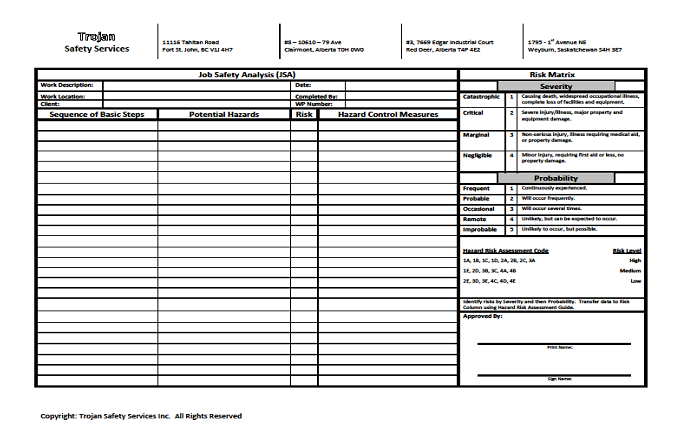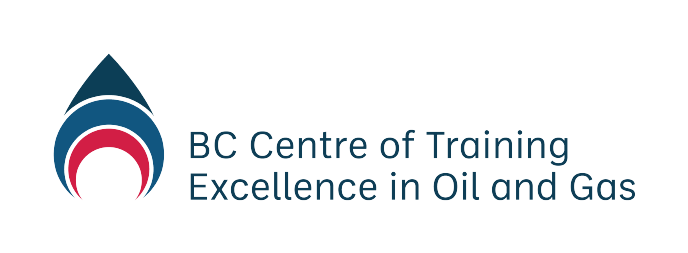-
Module 2.0 How to be Successful in this Course
-
Module 2.1 Introduction to Natural Gas
-
Module 2.2 The Natural Gas Industry in British Columbia
- Overview
- Learning Outcomes
- Natural Gas Science – The Simple Version
- Natural Gas Science – Chemistry
- Natural Gas Science – Physics
- Natural Gas Science – Units of Measurement
- Natural Gas Science – Geology
- Natural Gas Resources and Uses
- Oversight of the Natural Gas Industry
- Understanding Land Rights and Natural Gas
- Energy and the Future
-
Module 2.3 Upstream – Well Site Selection, Preparation and Drilling, Completion, Production, Water Recycling, and Reclamation
- Learning Outcomes
- The Upstream Sector – Extraction and Processing
- The Upstream Sector – Exploration and Site Selection
- The Upstream Sector – Preparation and Drilling
- The Upstream Sector – Completion
- The Upstream Sector – Production
- The Upstream Sector – Water Recycling
- The Upstream Sector – Reclamation
- Upstream Companies and Jobs in British Columbia – Companies
- Upstream Companies and Jobs in British Columbia – Industry Associations
- Upstream Companies and Jobs in British Columbia – Professional Associations
- New Vocabulary
-
Module 2.4 Midstream – Transportation, Processing, Refining
- Learning Outcomes
- The Midstream Sector
- The Midstream Sector – Processing Natural Gas
- The Midstream Sector – Liquefied Natural Gas
- The Midstream Sector – An Emerging Industry
- The Midstream Sector – Processing LNG
- The Midstream Sector – Proposed LNG Projects in British Columbia
- Transportation
- Midstream Companies and Jobs in British Columbia
-
Module 2.5 Downstream – Refining and Markets
-
Module 2.6 Health and Wellness in the Natural Gas Industry
-
Module 2.7 Safety
-
Module 2.8 Terminology and Communication
-
Module 2.9 Jobs and Careers
- Learning Outcomes
- Industry Outlook
- Technology is Changing Workforce and Skills
- Employment in the Natural Gas Industry
- Employment in the Natural Gas Industry – Types of Employment
- Employment in the Natural Gas Industry – Range of Jobs
- Employment in the Natural Gas Industry – High Demand Jobs and Occupations
- Occupational Education and Training
-
Module 3.0 How to be a Valued Employee
-
Module 3.1 Identifying Interests and Skills
-
Module 3.2 Looking for Employment in Natural Gas
-
Module 3.3 Applying for Employment in Natural Gas
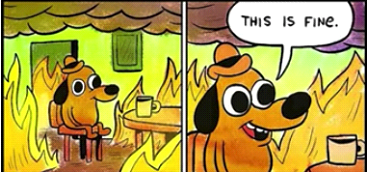
Personal safety is a shared responsibility with your employer. Employers also have a legal responsibility to ensure minimum safety requirements – set by the government (see the section on Safety Legislation and Legal Framework) – are present and followed in every workplace.
Safety is aserious concern for employers in the natural gas industry. Working with natural gas is dangerous; a slip, trip or fall, a mistake, or an error in judgement can result in serious harm or even death to a worker or other person on the job site. A catastrophic incident can harm workers on the job site, people in nearby communities and the environment—land, water, or air.
For these reasons, companies have strict safety rules, policies, and practices and they diligently enforce them. Slips/trips/falls and driving are the two biggest causes of time lost injuries in the industry.
To minimize risks, some companies have “zero tolerance” policies. This means anyone (employee, contractor, supplier, etc.)observed violating a safety rule or practice can be immediately and permanently dismissed. Examples include;smoking in prohibited areas, driving without a seatbelt, speeding, driving while using a cell phone, and substance abuse – regardless of the circumstances.
Impairment in the workplace can create a significant risk of injury and death. Impairment can have many causes, but the most common substance-related causes of impairment in the workplace arealcohol or legal drugs including cannabis, illegal drugs, prescription drugs to treat medical conditions, and over-the-counter medications. If you have a physical or mental impairment, you must not do work if the impairment may create a risk to yourself or anyone else.To ensure safe worksites, companies may have drug testing policies in placecovering pre-employment screening, post-incident or reasonable cause testing
Video 4: Safety is Personal, An Employer’s Story (7 minutes, 11 seconds)
Refusing Unsafe Work
Workers have the right to refuse unsafe work. If you have reasonable cause to believe that performing a job or task puts you or someone else at risk, you must not perform the job or task. You must immediately notify your supervisor or employer of what you believe are unsafe tasks or working conditions. Employers are obligated to take the appropriate steps to determine if the work is unsafe and remedy the situation.
Table 1 outlines the steps WorkSafeBC requires employees and employers to take in such circumstances.
If a worker refuses work because it’s unsafe, workplace procedures will allow the issue to be properly understood and corrected. As a worker, you have the right to refuse to perform a specific job or task you believe is unsafe without being disciplined by your employer. Your employer or supervisor may temporarily assign a new task to you, at no loss in pay.
Table 1: Steps to follow when work might be unsafe
| 1 | Report the unsafe condition or procedure. As a worker, you must immediately report the unsafe condition to a supervisor or employer. The investigation must take place in the presence of the worker and a worker representative of the joint health and safety committee or a worker chosen by the worker’s trade union. If there is no safety committee or representing trade union at the workplace, the worker who first reported the unsafe condition can choose to have another worker present at the investigation. If the supervisor/employer decide the worker’s concern is not valid, they will report back to the worker. |
| 2 | Investigate and ensure unsafe conditions are fixed yourself.
Sometimes you may not be certain it is safe to work even after a supervisor or employer has said it is safe to work. Check it out yourself. |
| 3 | Notify WorkSafeBC.
If the supervisor or employer is not able to resolve the unsafe condition, they must report it to WorkSafeBC. Similarly, if YOU are not certain the condition has been fixed, you can report it to WorkSafeBC. A WorkSafeBC prevention officer will investigate the situation and take steps to find a workable solution. |
Your Employer’s Safety Policies and Practices
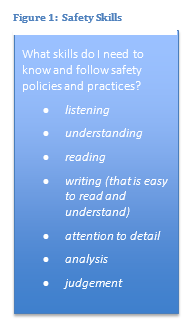
Employers are responsible for informing, training, and regularly updating all employees about how to complete their job duties safely and in compliance with relevant health, safety and environmental legislation and regulations. This applies whether employees are new to the company or new to a position. It also applies when something in a job and/or the workplace environment changes. For example, when new processes are introduced and/or there is a change in safety or environmental regulation, employees must be informed and trained appropriately.
How employers fulfill their safety responsibilities varies by company. Some of the most common ways are described in the following sections.
Remember in the natural gas industry: potential employers are looking to you to prove or demonstrate to them that you can work safely.
Orientation and Training
Workers under 25 and/or new to the job or facing new hazards on the job may be at higher risk of work-related injury or illness than the overall working population. In general, new employees are given a general workplace safety orientation and specific job/position-task training as required. Training may be formal (by an instructor in a classroom in the workplace or off-site) or informal (on the job) or a combination of both. The time required for safety orientation and training can also range, from a few hours to several days, depending on the complexity of the work involved.
New employees are also frequently “buddied-up” with an experienced, co-worker or manager for a period of time. The “buddy” shows the new employee how job duties are properly completed and ensures they stay safe while they learn. The duration of being “buddied-up” also varies, from one or more days, to in some cases, up to a year depending on the nature of risk associated with the job and job environment.</
Occupational Health and Safety Officers
Every company in the natural gas industry has a designated person responsible for overseeing Occupational Health and Safety in the workplace. We’ll talk about the details of this job in future modules.
The Occupational Health and Safety officer usually prepares and keeps up to date an occupational health and safety manual or handbook. The handbook includes all of the policies and procedures related to conducting work safely and keeping the workplace safe in the company. It includes information about where safety equipment (e.g., fire extinguisher, first aid kit) is located and incident response and evacuation procedures—what to do and where to go in the event of a fire or other incident.
While the Occupational Health and Safety officer should and will likely ensure that all workers know where the handbook is, this is something you need to take responsibility for yourself. As a worker, you need to familiarize yourself with the contents of the handbook, know where it is located at all times, and consult it frequently for updated information.
Safety Meetings
Safety meetings are another way employers’ keep employees and others focused on safe work practices and alert to potential safety risks. Most (if not all) employers require employees to begin the day with a “Toolbox or Tailgate” Safety Meeting.
A “toolbox” safety meeting is a short (e.g., 15 minutes) period at the start of the work shift, where you as a worker are briefed verbally or in writing about identified hazards that may be encountered during the day. A document, often called a “Safety Meeting and Hazard Checklist” (or something similar) is used to record identified hazards and any particular safety topics which are discussed. At the end of the meeting, you and the others present are required to sign the document. See Figure 2 , provides an real example of this type of document (courtesy of Trojan Safety Services).
Figure 2: Example safety meeting and hazard checklist form
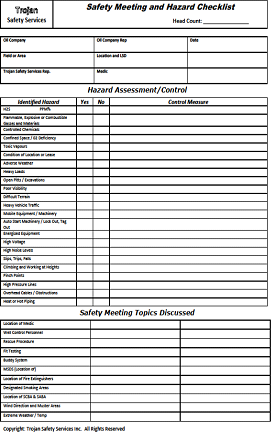
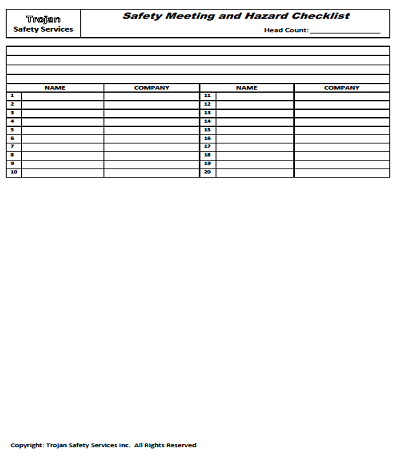
Job Safety Analysis or Job Hazard Assessment
A job safety analysis (JSA) or job hazard assessment (JHA) is something workers do before undertaking a task to ensure the task can be done safely. Workers use a JSA/JHA form (names can vary) to write down information and risks about the job task and the conditions where the task is being completed. Figure 3 is an example form (courtesy of Trojan Safety Services).
Generally, the form includes:
- Basic information, such as the name of the job, work location, date, and name of the person completing the job
- Detailed information about the steps to complete the job, potential hazards, risks, and measures taken to control hazards and risks.
As a worker, you would fillout a JSA/JHA form prior to beginning a job task so you are aware of and can follow any necessary requirements to complete the task given current conditions.
Figure 3: Sample Job Safety Analysis form
